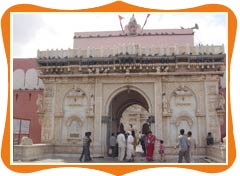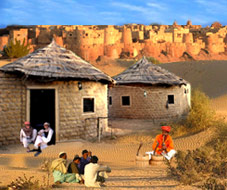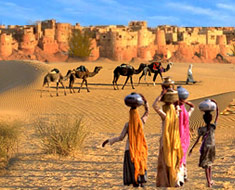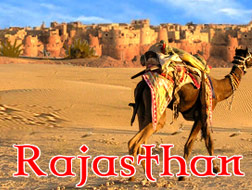 This dazzling fair is held twice in a year to honor the Karni Mata during the occurrence of holy Navratras in the months of March-April and September-October. The Karni Mata Fair is organized at the shrine of Karni Mata in Deshnok. This temple is also a popular and major tourist attraction of the state. The fair, as the name suggests, is dedicated to Karni Mata who is a local deity of the people of Rajasthan. Believed to have possessed supernatural powers, she lived in the 15th century and spent her entire life in serving the mankind. The rulers of Bikaner worship Karni Mata as their patron deity while the people of Bikaner hold her in high regard. She is also worshipped as a goddess by her principal followers called charans. Hordes of devotees visit this Mata's temple for their majestic blessings and to enjoy the mirth feast.
This dazzling fair is held twice in a year to honor the Karni Mata during the occurrence of holy Navratras in the months of March-April and September-October. The Karni Mata Fair is organized at the shrine of Karni Mata in Deshnok. This temple is also a popular and major tourist attraction of the state. The fair, as the name suggests, is dedicated to Karni Mata who is a local deity of the people of Rajasthan. Believed to have possessed supernatural powers, she lived in the 15th century and spent her entire life in serving the mankind. The rulers of Bikaner worship Karni Mata as their patron deity while the people of Bikaner hold her in high regard. She is also worshipped as a goddess by her principal followers called charans. Hordes of devotees visit this Mata's temple for their majestic blessings and to enjoy the mirth feast.Out of the two, the bigger fair is organized in the months of March-April at the Karni Mata Temple. The temple gates are thrown open to the devotees at 4.00 am in the morning during the fair. The temple is also known as the Rat Temple since rodents are found in large numbers roaming freely in the vicinity of the temple. In fact, it is considered auspicious if a rat or two runs over your feet. The holy rodents are referred to as the Kabas; spotting a white kaba is believed to be quiet an uphill task and is believed to be propitious. The rodents hold immense importance as it is believed that when one of the children of Karni Mata died, she brought him back in the form of a mouse. Many devotees can be seen here offering food to the kabas to seek their blessings.
The Karni Mata Temple is built using marble and stone, inside which lies a 75 cm long angelic image of the deity which is made up of astounding yellow marble. This enticing stature is beautifully adorned with a sparkling crown, jewelry, and garlands. During the Karni Mata Fair, it is the Charan priests who proceed with the affairs of the fair by performing the Mangla-ki-Arti which is followed by a bhog to worship the deity. Being the patron deity of the royal house of Bikaner, the festival enjoys a royal touch with the royal family of Bikaner paying obeisance to the goddess during the fair. The Karni Mata Fair holds immense importance for the Rajasthani Hindus which can be seen in large numbers during the Navratra days. The ultimate knowledge and joy of the marvelous feast can only be grabbed by self visiting the fair.










